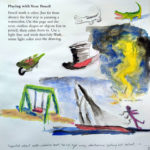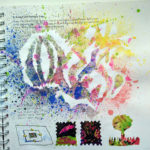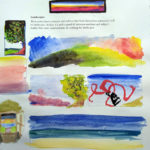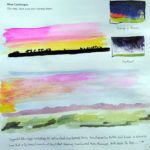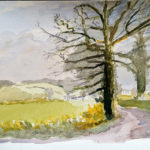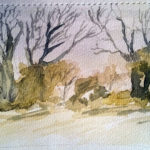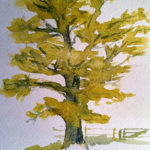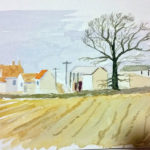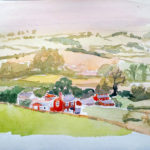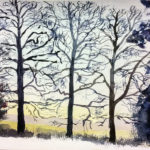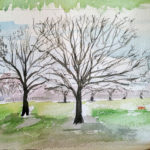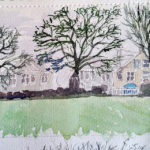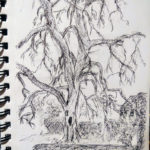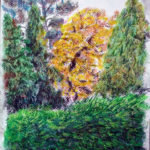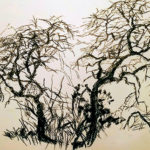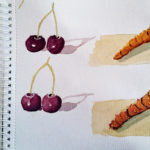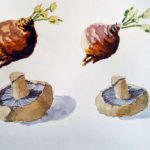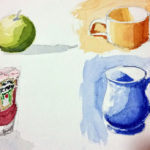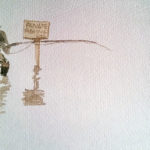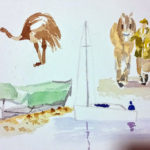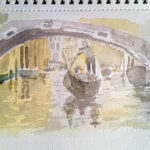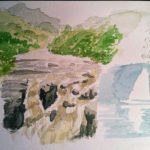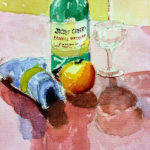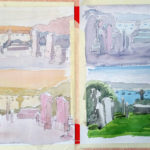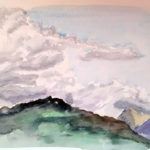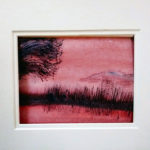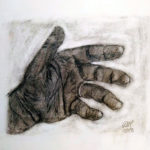Beginnings
Anyone can learn to draw, just like anyone can learn to read music, play an instrument, write a decent essay, garden or cook. In fact everyone should learn to draw, I believe life is richer as a result. Like all these things, drawing is just a physical skill we may or may not have developed very much. Like other skills, just because some people are especially good at it and can make a living from it, the rest of us shouldn’t be put off from discovering its benefits. For me, art is a vital human endeavour which allows you to reach out and connect with the world that surrounds you; not the only way, of course, but a great way. Drawing is good for us. But we don’t always do what we know to be good for us, do we…
Watercolour for the Artistically Undiscovered
It is difficult to say for sure what made me pick up Watercolour for the Artistically Undiscovered, aged 44. I had come to believe that making art is natural and human, it is just social convention and lack of self-belief which deter a person from putting pencil or paintbrush to paper. However, do people do something because they know it is good for them, or do they do things because they are responding to a desire? ‘Following your desires’ has had mixed reception over the course of human history, but I’m increasingly a devotee. Simply, I realised I wanted to learn to draw/paint. The specific motivator was probably visiting lots of art galleries and exhibitions as part of a Masters course I was studying. Seeing all that creativity flowing into work, and slowly experiencing what awakens as it flows back out into me, perhaps explains some of this desire and willingness to overcome the obstacles and demons which fed my apathy and told me becoming artistic was a pointless exercise.
One challenge this book presented me with was a fear that I just wasn’t creative. “Draw a hat…”, “Well, what type of hat?… What if I draw a rubbish hat?… Yes, that is a rubbish hat…” Or alternatively, “Draw a picture using colours that you like…” “What colours SHOULD I like?!… How do I know if I really like them or not?… These colours I said I liked – er, I don’t think I really like them after all…” Looking back on the process, it highlights to me a profound deficiency I had taken with me into the project, and profound deficiency in my life – NO sense of what I liked, my tastes, my will. This book started unlocking some doors but real clarity and forward movement on this only came much, much later – and through another artistic endeavour…
Watercolour for the Artistically Undiscovered was well constructed, easy to work through and fun. When learning to draw or paint, I don’t think it really matters what you do so long you do it regularly and for a long enough time. So kind of like losing weight…
A few examples from the book…
Alwyn Crawshaw's Watercolour Painting Course
There is something I find satisfying about following instructions and coming out with a pleasing result, like following a recipe in a book. I have always been a ‘manuals person’, whether cooking, Ikea furniture, or learning computer software. However, with art and true creativity, this is not a good habit. Recently (as I write this revision in 2023), recently an art tutor kindly commented to me – “Dom, perhaps you should stop doing art classes and start doing some art… I would be interested to see what you produce…” There is safety in manuals and art classes… But back to 2017, when I worked through Alwyn Crawshaw’s Watercolour Painting Course I found on the shelf of my parents’ home.
If I had to come up with my top three ‘things I wanted to be able to draw’ it would be 1) figures, 2) portraits and 3) trees. And I enjoyed that there were so many trees to draw in Alwyn’s course. I have always been moved by trees… bare, skeletal winter trees, trees whose naked branches dissolve in the mist, the new spring shoots which from a distance makes the tree appear buzzing and bursting into life, late summer trees with their heavy green – an unwelcome reminder of an imminent return to school (whether as a student or a teacher). And of course trees with autumn leaves which conjure for me a melancholy or wistful nostalgia which makes the heart ache. Trees remind me of the passage of time, but also of how time sometimes seems to just stand still. And the smell of trees – pine forests, eucalyptus groves, soggy walks in woods – smell being the sense that seems to have the most direct route to the memory, mind and spirit. One of the most vivid childhood memories I have is walking in the early morning mist and drizzle through the cherry blossom on the strays of my birth town, Harrogate.
Before I started drawing trees, I always wondered how you could draw all those branches and twigs, and if you didn’t, how would it look realistic? The simple answer, following Crawshaw’s advice, was that a) you don’t draw everything, and b) it still does look realistic. It taught me another lesson useful in both art and life. When we look at something, anything, we are not looking at what is ‘there’, whether that is a person or a situation. We cannot possible take in everything. It is much closer to the truth that we see what we want to see, what attracts us or what displeases us, and usually that is to do with something about how we view ourselves. We impose the meaning and structure on what we view. Art can certainly help us understand that.
After Alwyn’s book, I continued with watercolour for a while, looking at another couple of books and did a day’s watercolour course. Quite quickly though I moved away from watercolour, wanting to ‘learn how to draw’ and so discovered Betty Edwards and her wonderful book Drawing with the Right Side of the Brain.
A few more examples of my work from Alwyn’s course, and a few other watercolours…


